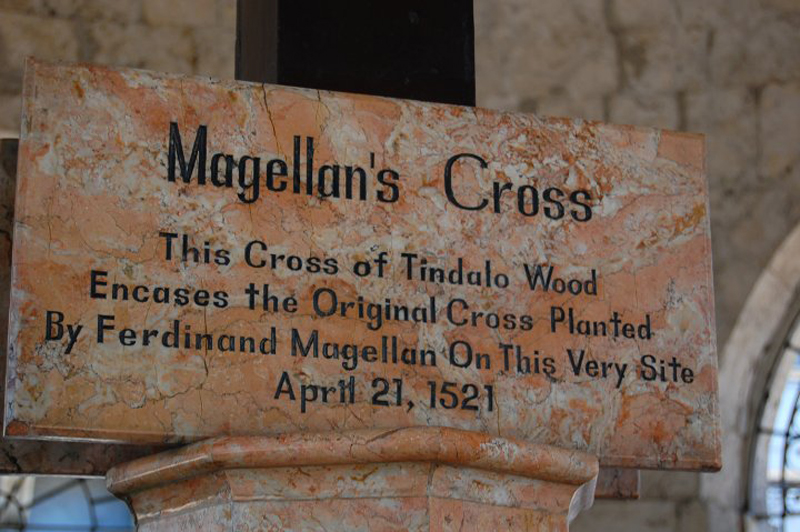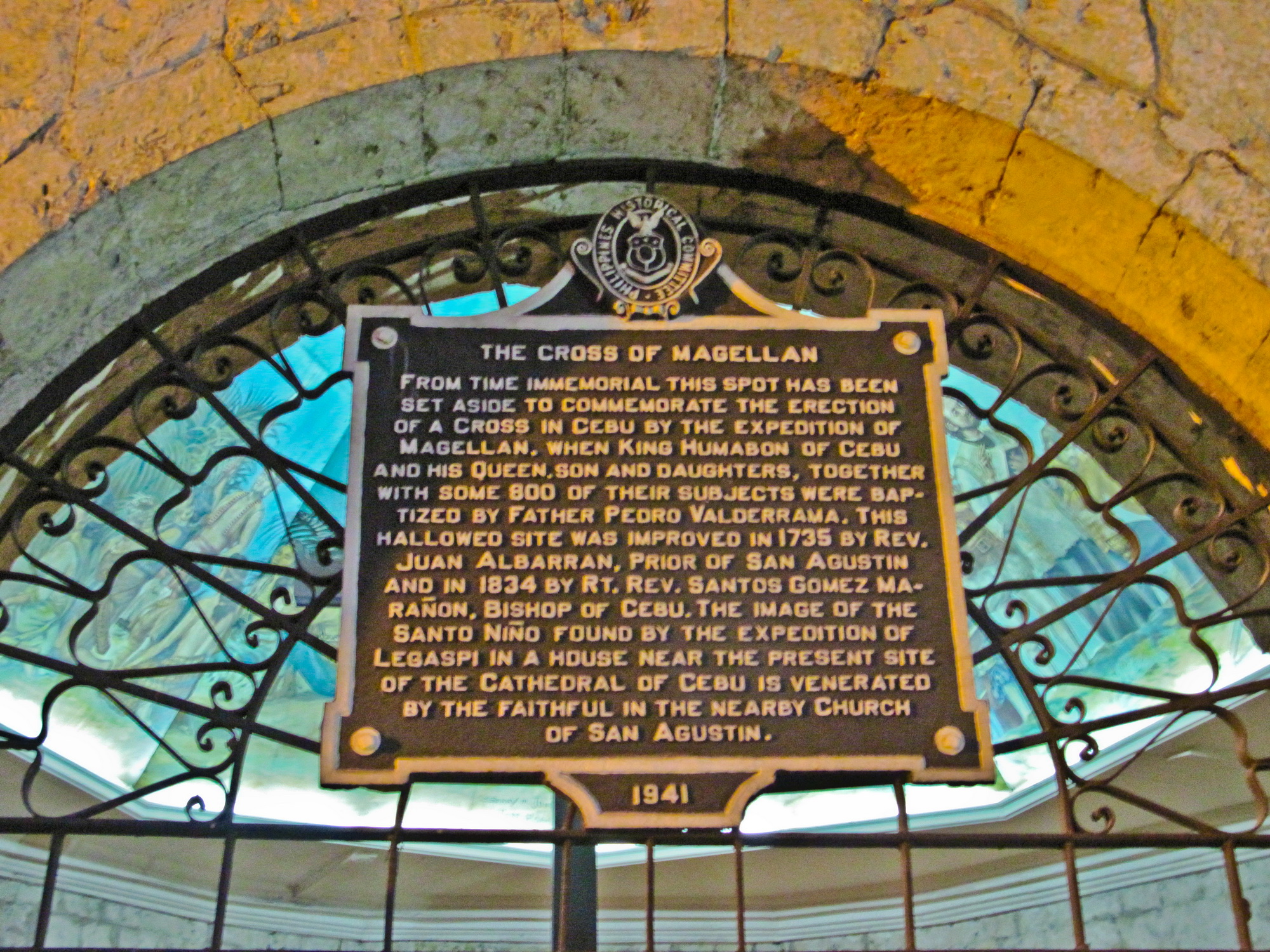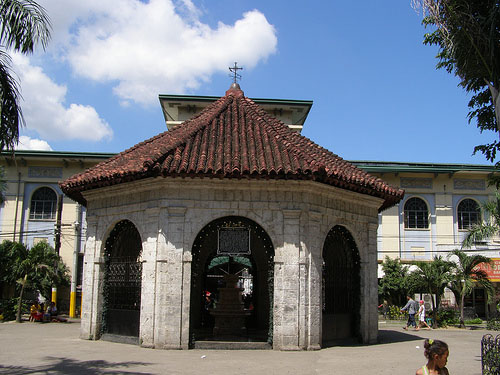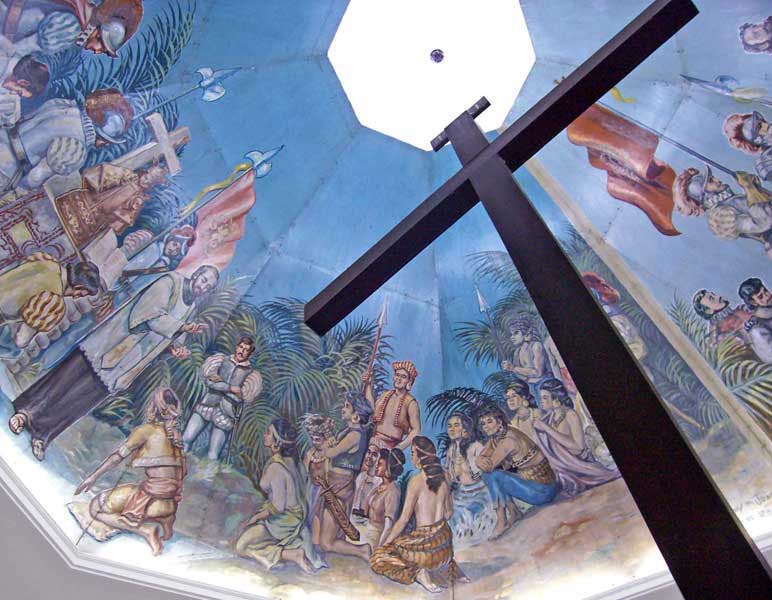Magellan’s Cross

When Portuguese explorer Ferdinand Magellan, working for the King of Spain, landed in Cebu in 1521, he was warmly accepted by the chieftain of Cebu, Rajah Humabon, his wife Queen Juana, and their people. Magellan then induced Humabon to structure an alliance with Spain. Subsequently, Humabon, his wife and their people were baptized into the Roman Catholic faith.
 On April 14, 1521, Magellan planted a wooden cross on the shores of Cebu to celebrate the baptism of Humabon, his wife and their people, and to signify the stronghold of Christianity in the Philippines. The cross that Magellan planted has been known from that point forward as the Magellan’s Cross. Since 1834, the cross has been housed inside a little church or stand that is shape as a gazebo and made of adobe and red tiles.
On April 14, 1521, Magellan planted a wooden cross on the shores of Cebu to celebrate the baptism of Humabon, his wife and their people, and to signify the stronghold of Christianity in the Philippines. The cross that Magellan planted has been known from that point forward as the Magellan’s Cross. Since 1834, the cross has been housed inside a little church or stand that is shape as a gazebo and made of adobe and red tiles.
The kiosk is spotted next to the Basilica Minore del Santo Ni?o on Magallanes Street and before the city hall building of Cebu City. A plaque was put just above the door of the kiosk in 1941.
 The plaque says that “From time immemorial this spot has been set aside to remember the erection of a cross in Cebu by the Expedition of Magellan. When King Humabon of Cebu and his Queen, offspring and girls, together with practically 800 of their subjects were baptized by Father Pedro Valderrama. This sacred site was improved in 1735 by Rev. Juan Albarran, Prior of San Agustin and in 1834 by Rt. Rev. Santos Gomez Maranon Bishop of Cebu. The image of the Santo Nino discovered by the expidition of Legaspi in a house close to the present site of the Cathedral of Cebu is venerated by the faithful in the nearby Church of San Agustin.”
The plaque says that “From time immemorial this spot has been set aside to remember the erection of a cross in Cebu by the Expedition of Magellan. When King Humabon of Cebu and his Queen, offspring and girls, together with practically 800 of their subjects were baptized by Father Pedro Valderrama. This sacred site was improved in 1735 by Rev. Juan Albarran, Prior of San Agustin and in 1834 by Rt. Rev. Santos Gomez Maranon Bishop of Cebu. The image of the Santo Nino discovered by the expidition of Legaspi in a house close to the present site of the Cathedral of Cebu is venerated by the faithful in the nearby Church of San Agustin.”
When you enter inside the kiosk, you will see the Magellan’s Cross situated in the center. The ceiling above the cross has works of art that depict the arrival of Magellan and the planting of the cross, and the baptism of Rajah Humabon, his wife and their subjects.
 A sign beneath the cross states that the definitive cross is encased inside a cross made of tindalo wood. That was carried out to secure the original Magellan’s Cross from individuals who chipped down parts of the cross in the conviction that the cross has supernatural powers or for souvenir purposes.
A sign beneath the cross states that the definitive cross is encased inside a cross made of tindalo wood. That was carried out to secure the original Magellan’s Cross from individuals who chipped down parts of the cross in the conviction that the cross has supernatural powers or for souvenir purposes.
However, some historians and other people believe that the original cross had been destroyed or had vanished after Magellan was killed, and that the cross encased inside the tindalo wood is an imitation that was planted there by the Spaniards who came after the passing of Magellan.
Today, the Magellan’s Cross is a well known vacation destination in Cebu.It is also a symbol of Cebu City and the kiosk?s image can be found in its official city seal. Moreover, numerous government and non-government associations situated in Cebu utilize the Magellan’s Cross or the kiosk in their seals and logos. The Magellan’s Cross is seen as the image of the establishment of Roman Catholicism in the Philippines.
Getting There : By means the place is accessible through riding a taxi cab, jeepney or you can rent a car. When hiring a taxi cab just ask the driver to drop you off at this place or at the entrance of Basilica del Sto. Ni?o. When you?re commuting be sure to ride those jeepneys heading from and to Capitol (signage) or Mabolo jeepneys.
